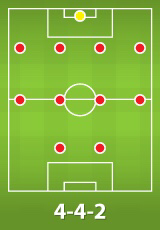The formation that a delivery team adopts is normally set out at the beginning of a piece of work during the Inception process. Some of questions that may be asked during an Inception are ‘what are the keys roles and competencies required for this delivery’ and ‘what does our A-Team look like’? The answers to these questions may differ to the actual structure of the team that forms as it is possible that there may be dependencies and constraints due the other work in progress within your organisation and the availability of resources.
However, when you have no constraints on the resources at your disposal, you need to start thinking like a football manager. Ahead of you is the next match (release) and you need to pick the right team in order to win the game within 90 minutes (deliver on time). Your team selection may differ from the last match as the opposition (technology) has changed and you need to employ a different set of tactics (team skills, knowledge and expertise) in order to score the goals to win the game.
The standard 4-4-2 may be the starting point for most deliveries. But who will play in each position?
The Scrum Master may be seen as the goal keeper for the team. They will help to protect the opposition from scoring or the delivery team from scoring an own goal (by ensuring agreed processes are followed and impediments are removed) which would make winning the game and delivering on time more difficult.
Roles such as the Product Owner (who is the team captain and drives the team forward), Business Analyst, Solutions Architect and Designer/User Experience expert may form the teams defence. This group of players provide the foundation upon which attacks (the development) can be built.
The midfield of the team is likely to be formed from developers who have the flair and creativity to to generate scoring opportunities for the strikers (testers) who have the ability to apply the finishing touch to a flowing move (getting user stories to done). If the opportunity to score doesn’t present itself (there is a defect), the strikers can hold up the the ball so it can be recycled back to the midfield in order to create a new scoring opportunity (fix the bug and re-test).
As the match (delivery) progresses, you may need to keep an eye on the fitness/stamina of your players (identifying if certain roles are still required). It may be possible for you to make substitutions and switch formations in order to create a higher tempo. For example, at the beginning of the delivery you may require the skills of a Designer/User Experience expert, however, as the development progresses their effectiveness may diminish and there may be value in substituting them for another developer or tester, which could make the team more attacking, moving to a 3-4-3 or 3-5-2 formation.


During the course of the match a football manager may have to deal with injuries and players being sent off. Some injuries may be a small knock (short-term sickness) which can be run off (accommodated) without the need for substitutions (new team members), while more serious injuries (long-term sickness) may call for a change in personnel. On other occasions you may find the size of your team reduced due to a player being sent off, with them being moved onto other deliveries or leaving the organisation. These situations may call for team members to play out of position and fill a role that may not be their ideal skill set. If a you find that a critical role, such the goal keeper or captain (Scrum Master or Product Owner), is given a red card, you may want to ensure a substitution takes as soon as possible to return key skills to the team.
So what formation is your team currently playing?

